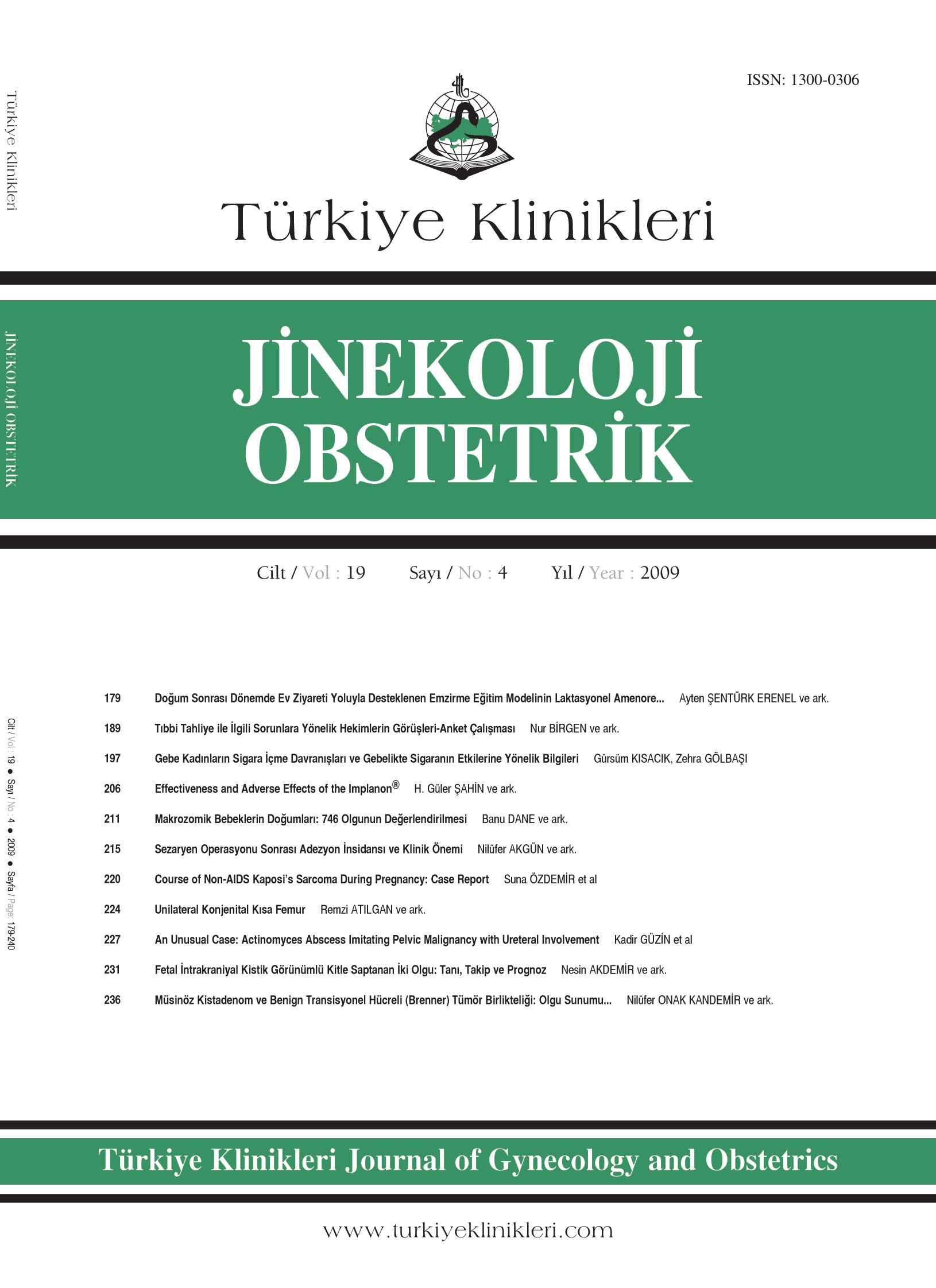Open Access
Peer Reviewed
CASE REPORTS
2695 Viewed1881 Downloaded
Coexistence of Mucinous Cystadenoma and Benign Transitional Cell (Brenner) Tumor: Case Report and Discussion on Histogenesis
Müsinöz Kistadenom ve Benign Transisyonel Hücreli (Brenner) Tümör Birlikteliği: Olgu Sunumu ve Histogeneze Yönelik Bir Tartışma
Turkiye Klinikleri J Gynecol Obst. 2009;19(4):236-40
Article Language: TR
Copyright Ⓒ 2020 by Türkiye Klinikleri. This is an open access article under the CC BY-NC-ND license (http://creativecommons.org/licenses/by-nc-nd/4.0/)
ÖZET
Over dokusunda müsinöz ve transisyonel hücreli (Brenner) tümör birlikteliğinin histogenezi tartışmalıdır. Her iki tümörün genetik ve morfolojik benzerlikleri ortak bir kökenden geldiklerini düşündürmektedir. Altmış yaşında kadın hasta kasık ağrısı ile bize başvurdu. Klinik muayenede sağ adneksiyal bölgede hassasiyet ve kitlesel lezyon saptandı. Radyolojik incelemede sağ over yerleşimli, 122 x 90 x 82 mm boyutlarında, hiperekojen, multiloküler kistik lezyon izlendi. Hastaya total abdominal histerektomi ve bilateral salpingo-oofrektomi operasyonu uygulandı. Histopatolojik incelemede, over dokusunda müsinöz kistadenom komşuluğunda benign transisyonel hücreli tümör saptandı. Benign transisyonel hücreli tümörlerin yaklaşık %30'unda diğer yüzey epitel kökenli over tümörleri ile birliktelik görülmektedir. Bu çalışmada müsinöz kistadenom ve transisyonel hücreli tümör birlikteliği, bu tümörlerin gelişim mekanizmasına yönelik literatür bilgileri eşliğinde tartışılmıştır.
Over dokusunda müsinöz ve transisyonel hücreli (Brenner) tümör birlikteliğinin histogenezi tartışmalıdır. Her iki tümörün genetik ve morfolojik benzerlikleri ortak bir kökenden geldiklerini düşündürmektedir. Altmış yaşında kadın hasta kasık ağrısı ile bize başvurdu. Klinik muayenede sağ adneksiyal bölgede hassasiyet ve kitlesel lezyon saptandı. Radyolojik incelemede sağ over yerleşimli, 122 x 90 x 82 mm boyutlarında, hiperekojen, multiloküler kistik lezyon izlendi. Hastaya total abdominal histerektomi ve bilateral salpingo-oofrektomi operasyonu uygulandı. Histopatolojik incelemede, over dokusunda müsinöz kistadenom komşuluğunda benign transisyonel hücreli tümör saptandı. Benign transisyonel hücreli tümörlerin yaklaşık %30'unda diğer yüzey epitel kökenli over tümörleri ile birliktelik görülmektedir. Bu çalışmada müsinöz kistadenom ve transisyonel hücreli tümör birlikteliği, bu tümörlerin gelişim mekanizmasına yönelik literatür bilgileri eşliğinde tartışılmıştır.
ABSTRACT
The histogenetic mechanisms of the coexistence of ovarian mucinous tumour and transitional cell (Brenner) tumour remain controversial. Genetic and morphological similarities of the two tumors suggest that they may have a common origin. A 60-year-old female presented with inguinal pain. Right adnexal sensitivity and a solid tumoral mass were detected on physical examination. Radiological studies revealed a hyperechogenic, multilocular and cystic lesion with of 122 x 90 x 82 mm size located in the right ovary. Total abdominal hysterectomy and bilateral salphingo-oophorectomy were performed. Histopathological examination of the surgical specimen revealed the diagnosis of ovarian benign transitional cell tumor. Approximately 30% of benign transitional cell tumors are associated with other ovarian tumors of the surface epithelium. The coexistence of mucinous cycstadenoma and transitional cell tumor with regard to the developmental mechanisms of these tumors has been discussed here in the light of literature findings.
The histogenetic mechanisms of the coexistence of ovarian mucinous tumour and transitional cell (Brenner) tumour remain controversial. Genetic and morphological similarities of the two tumors suggest that they may have a common origin. A 60-year-old female presented with inguinal pain. Right adnexal sensitivity and a solid tumoral mass were detected on physical examination. Radiological studies revealed a hyperechogenic, multilocular and cystic lesion with of 122 x 90 x 82 mm size located in the right ovary. Total abdominal hysterectomy and bilateral salphingo-oophorectomy were performed. Histopathological examination of the surgical specimen revealed the diagnosis of ovarian benign transitional cell tumor. Approximately 30% of benign transitional cell tumors are associated with other ovarian tumors of the surface epithelium. The coexistence of mucinous cycstadenoma and transitional cell tumor with regard to the developmental mechanisms of these tumors has been discussed here in the light of literature findings.
MENU
POPULAR ARTICLES
MOST DOWNLOADED ARTICLES





This journal is licensed under a Creative Commons Attribution-NonCommercial-NoDerivatives 4.0 International License.











